All About Robins - Robin Facts & Information
Robins are a wonderful bird that has been seen throughout the UK so often and for so long that they're an unofficial national bird of the UK. The robin song is a quintessential piece of the dawn chorus, and we can't imagine a day without them.

In this article, we're going to cover everything about robins, from the things that they eat to their little white belly.
About Robin red breast birds
Robin redbreast is a classic UK bird, famous for its bright red breast that's all the more noticeable during the winter when they stand out against the white snow.
Male robins and female robins look precisely the same as one another and are roughly the same size, too. The young are smaller, of course, and don't have a red breast.

Their song keeps on going for the whole year, and despite how small and sweet they appear, they are very aggressive over territorial disputes.
When do Robins get their red breast
Robins first develop the feathers for their red breast when they're between two and three months old. During this period of time, they go through a partial molting season, which leads to them losing speckled feathers on their breast, and gaining red ones.

Robins themselves are hatched without the red breast in order to avoid territorial disputes. Male and female robins are aggressive over their territory, and if they see another red breast, they can go after it and the bird to which it is attached. Through evolution, the young have developed less distinctive chests, in order to hide that they're robins, a little.
Robins habitats - Where do Robins live?
Robins reside throughout the whole of the UK, with the birds themselves being denizens of woodland, hedgerows, and gardens. They're a common sight on garden bird tables, and a welcome one too - they're small enough to be exceptionally cute, and they'll eat almost anything that you might put out for them.
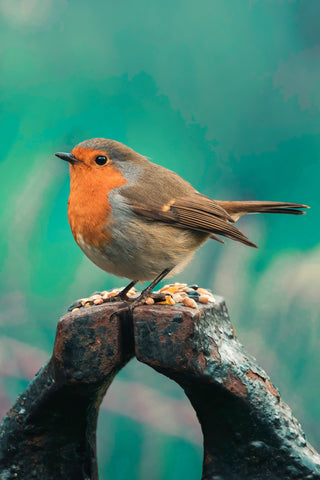
They easily encompass the whole of the UK, with urban robins easily making their way into cities and living there. Robins sing in cities, as they do everywhere, making them an essential part of the morning chorus.
The only regions of the UK that you cannot find robins in are exceptionally extreme places, such as the Scottish highlands - the birds are too small to live there, in such cold spots.
How long do Robins live?
A European robin is with us for around two years at most. This is an indication of how short it takes for them to become adults from being juveniles - as little as three months.
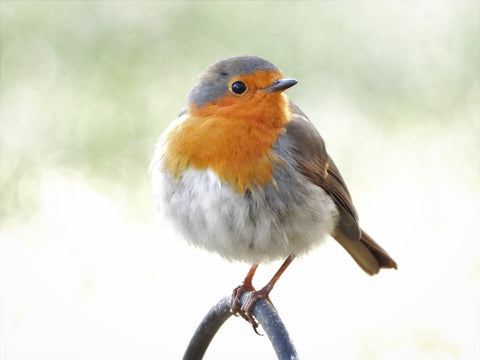
The European robin is a very small bird indeed and, despite the down feathers covering them, they can't stand too much cold. This means that when it comes to the winter, the bird will generally be fine for a while, before simply focussing on making it to the new year. When the spring hits and temperatures improve, things are a little easier for them.
As the European robin is a two-year resident of our garden bird tables, the male and female robins can be seen year-round. The reason taht you typically don't see too many different species of animal in different seasons is that they may be a little seasonal. Whether they hibernate, go into torpor, or simply migrate, they may not appear in the winter. The European robin, though, can be seen throughout the winter, typically rooting through different regions of bushes and gardens to find bugs and seeds.
Characteristics of a Male Robin & Female Robin & What do they look like?
A male robin and a female robin are notoriously similar. Never fear, though, we're going to run through a few differences between male and female robins.
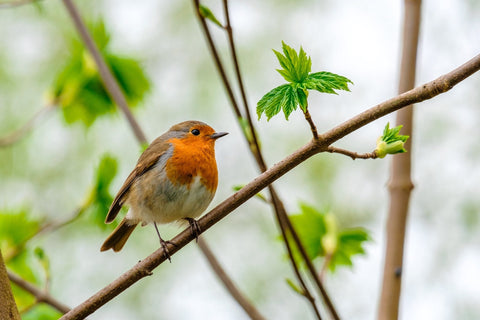
Physical differences
The physical differences, frustratingly, are virtually zero. There have long been tales about how only male robins have red breasts, or how female robins have white wing bands. This isn't true, though - both sexes display these characteristics.
A male robin will generally be a little bigger than a female robin, but this isn't the kind of thing that you can tell by eye - you'd need to strap them down and use a measuring tool. Even in that situation, it might not be entirely helpful - a female robin could be larger than her male counterpart if she is carrying eggs during the breeding season.
Behavioral differences
The only reliable way to tell which robin is male and which is a female robin is by observing their behavior. Robins eat as part of their courtship rituals - this is known as courtship feeding. The male will always be the one feeding the female.
On another note, if you see a robin constructing a nest while another is nearby, the constructor is the female robin. She will also be the only robin to incubate the eggs.

When do Robins Nest?
The robin nesting and courting period happens during the spring. If there's a particularly mild, warm winter, then the season can begin as early as January. Typically, though, the breeding season starts in March.
As with a number of British birds, the female robin will construct the nest, and the male robin will typically gather a large volume of her food during the mating season. During the breeding period, a male can supply a female with up to a third of her total daily calories!
Robins can nest in all sorts of different locations. Their nests are quite strong indeed, which means that when they're finished they can survive in a number of different locations. Adult robins can build and maintain a nest in a shed, a kettle, or even a coat pocket - they're very tenacious!
These Robin nest boxes are built specifically for this species.
What makes a breeding season longer?
Since robins are year-round birds, the thing that prevents them from breeding for the whole year is the unfavorable conditions that come with the winter. Robins don't enjoy the cold, typically staying away from it as much as they can.
As climate change has a real and noticeable effect on the world's wildlife, British robins have been experiencing a breeding period that's been getting longer and longer. To put it simply, the winters have been shortening, leading to more days with favorable conditions for the robins appearing. This has increased the length of the season over time.
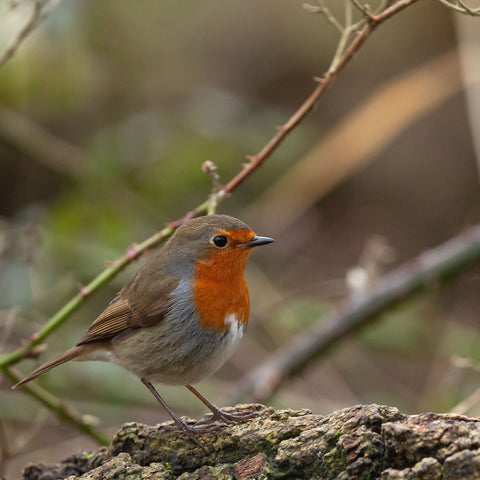
Baby Robins and breeding
The female robin lays all of the eggs in her clutch at a rate of one per day. She will typically have a total of four to six eggs, and they'll be laid daily, usually first thing in the morning.
After the clutch is complete, the female incubates the eggs on her own. After thirteen days of incubation, the chicks hatch, leading to the naked young in the nest. The female immediately discards to the eggshells, sometimes eating them for the extra calcium.
The young grow feathers over time, starting at three days old. By five days old, they'll start to open their eyes for the first time.
During and after the time at which the juvenile robins develop flight feathers, the male will tend to the young - gathering food for them and providing some level of warmth for them as their feathers finish growing. While that's occurring, the female will prepare the nest for the next clutch. Typically, a pair of robins can have two to three clutches in a season, and four isn't completely unheard of.
These numbers are quite high for garden birds, which is another reason their nesting season is long compared to other birds.
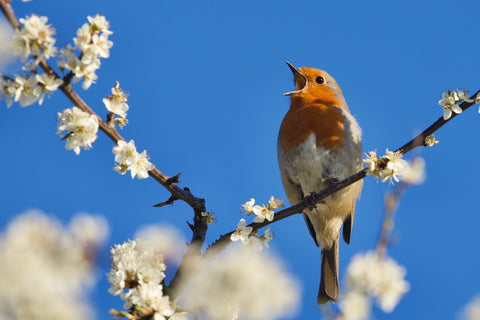
The start of the nesting process
The very start of the nesting process is a time that's very interesting for bird watchers since it's typically very touch-and-go whether the robins will return to the nest.
If a pair of robins believe that the nest has been at all disturbed, they will desert the nest without thinking twice of it.
For this reason, it's best to steer clear of robin nests unless the specific birds you're dealing with are used to people in their nearby area.
Where do Robins live?
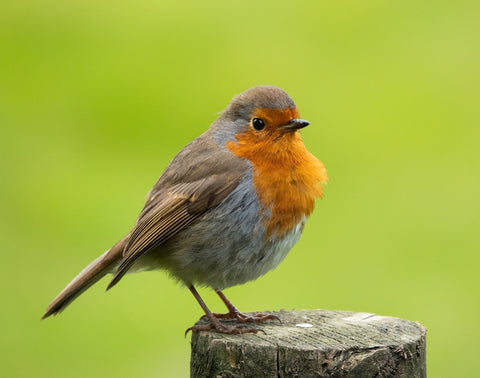
Robins nest and live in a number of different locales throughout the UK. Primarily, they live in gardens and woodlands. As Christmas cards reliably inform us, their cup-shaped nest is typically found on or near the ground - in hollows within vegetation. As they're small birds, they typically enjoy the security that a well-concealed nest brings them.
What do Robins eat
One thing that's very rarely seen on Christmas cards is a robin stuffing its face - perhaps because it's quite rarely seen by an observer.
The birds themselves eat a lot of high-protein food, such as worms and seeds. They do, sometimes, eat other insects, but they can typically get more calories in a shorter period of time by honing in on some worms and other invertebrates. This diet of insects is one of the reasons why our feathered friends belong to the old-world flycatchers family.
Less common food options
In quite rare situations, you can see a robin eating fruit, typically berries from a bush. It is rare to see them eating these, as berries contain a lot of sugar, rather than any protein, which is what robins often prefer to eat.
Robins Predators

The mortality of robins is quite high indeed, which is a little surprising to hear. The truth of the matter is that robins die from all sorts of different things, not just predators.
The primary predator of robins is, oddly, the cold. Over the course of an exceptionally cold night, a robin can use up to ten percent of its total body fat to stay warm. If it's not able to feed well every single day to retain its overall body weight, then it is unlikely to live.
The primary animal predators for robins are birds of prey and housecats. Because the birds are very small, it's easy for these animals to track down a robin by tracking either its brown back or white belly.
The high mortality rate of robins is typically balanced by the extreme effectiveness of robins in a mating - each year robins have up to four clutches, as we mentioned above.
Do female robins have a red breast UK
Yes, female robins in the UK do have a red breast. The European robin is identical between the sexes, which means that both sexes have a red breast.
How to attract Robins into your garden
As we said in the predators section of the article, robins can use a lot of their body fat on a particularly cold night. This means that they need a steady and reliable source of food to ensure that they survive. We would recommend providing this source of food in a feeder or a bird table - that will attract a large number of robins to your garden.
The best choice for robins is to select a bird feed mixture that contains both seeds and mealworms, or a similar source of protein. Fat balls are also great options for them since they're so high in calorie density. We have specialist bird feed for robins to give you the best chance of attracting these wonderful birds.
Five facts about Robins
-
The males and females are visually indistinguishable.
-
The robin sings nearly all year round.
-
They prefer to eat high protein food, such as insects and fat balls.
-
A pair can nest in nearly any spot, from a tree to a wellington boot.
-
At night, their song can be heard near streetlights.






